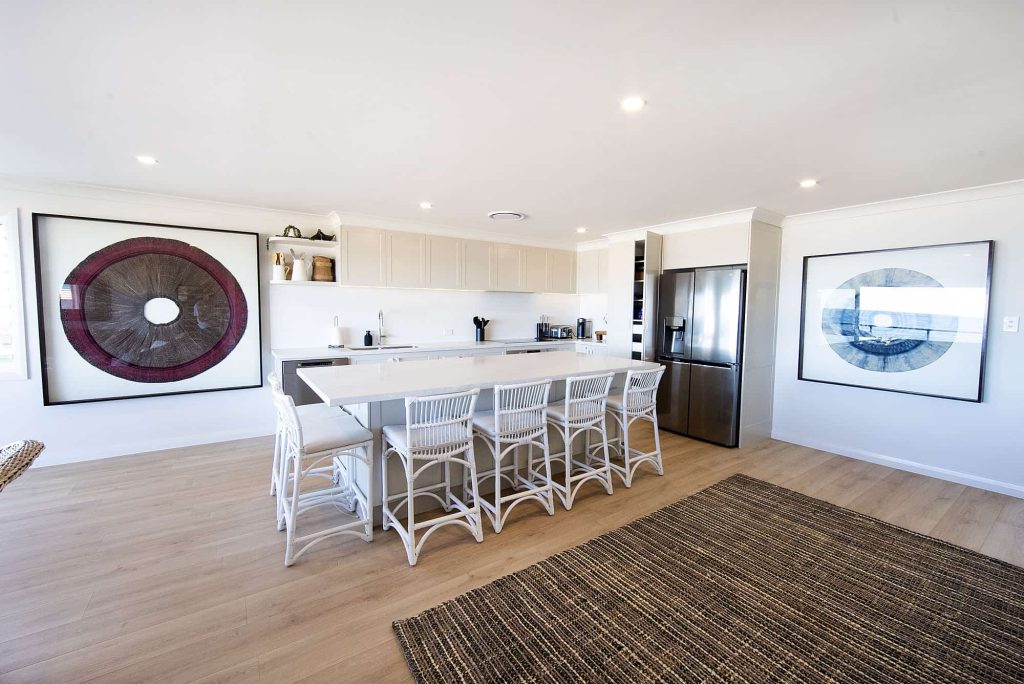Benefits of Dual Occupancy Homes
Benefits to Building Dual Occupancy Homes
Dual occupancy homes have become a practical and popular solution for many Australians, especially investors and homeowners looking for additional income. These properties consist of two dwellings on a single lot, offering versatile living arrangements and financial benefits. As housing demands grow, dual occupancy homes are increasingly seen as a smart investment and a means to optimise land use.
Dual occupancy dwellings in Australia come in various forms, including townhouses, duplexes, apartments, and detached houses. Understanding the distinctions between attached and detached dual occupancy homes can help investors and homeowners make informed decisions about which option best suits their needs and goals.

Dual Occupancy Categories
Attached Dual Occupancy:
These are two dwellings on one lot that are physically connected. Examples include townhouses and duplexes. They share at least one common wall, making them a cohesive structure on the same land.
Detached Dual Occupancy:
In this category, there are two separate dwellings on one lot. Unlike attached homes, these do not share any walls and are entirely independent structures. Detached dual occupancy homes offer more privacy and space between the dwellings.
Types of Dual Occupancy Homes
Townhouses
Townhouses are a popular form of attached dual occupancy. They typically share one or more walls with the neighbouring unit but have their own separate entrances and amenities. Townhouses offer the feel of a single-family home with the added benefit of shared walls reducing construction costs.
Detached Houses
Detached dual occupancy homes are two separate houses on the same lot. This setup provides the most privacy and independence between the units, making them ideal for families who want to live close to each other while maintaining separate living spaces. They are also appealing for investors looking to maximise rental income with distinct, marketable properties.
Duplexes
A duplex consists of two attached units that are mirror images of each other or have different layouts. Each unit can be occupied independently, providing a great option for those who want to live in one unit and rent out the other for additional income. Duplexes maximise land use while offering a high degree of privacy between the units.
Apartments
While traditionally considered multi-family dwellings, apartments can also fall under dual occupancy when two units are designed within a single building structure. These are ideal for urban areas where space is limited, and the demand for rental properties is high.
Benefits of Dual Occupancy Homes

Financial Benefits
Building Equity and Property Value:
Dual occupancy homes can significantly boost your property’s equity. With two dwellings on one lot, the combined value often exceeds that of a single larger home. This increase in property value can provide substantial financial leverage.
Strata Title and Separate Valuation:
When dual occupancy properties are built under a strata title, each dwelling can be valued and sold separately. This separate valuation can create instant equity growth, allowing investors to capitalise on the market value of two individual homes rather than one.
Supplementary Income from Renting or Airbnb:
Dual occupancy homes provide an excellent opportunity for generating supplementary income. Owners can live in one dwelling and rent out the other, either long-term or as a short-term Airbnb rental. This rental income can significantly offset mortgage payments and contribute to overall financial stability.
Potential for Mortgage Offset:
The income generated from renting out one of the dwellings can be used to pay off your mortgage faster. This not only reduces financial stress but also allows you to build equity in your property more quickly.
Tax Reductions:
Dual occupancy homes can offer various tax benefits, including deductions for depreciation, maintenance, and management expenses. These tax reductions can enhance the financial viability of dual occupancy investments.
Social and Family Benefits
Housing for Elderly Parents or Older Children:
Dual occupancy homes are ideal for families looking to accommodate elderly parents or adult children. Each dwelling provides independence and privacy while keeping family members close by. This arrangement can offer peace of mind and convenience, particularly for multi-generational living.
Independence While Living Close to Family:
For families who want to live near each other without sacrificing personal space, dual occupancy homes provide the perfect solution. Each dwelling offers the autonomy of a separate residence while maintaining proximity to loved ones.
Multigenerational Living Solutions:
Dual occupancy homes are well-suited for multigenerational living. They allow different generations of a family to live together while maintaining separate households. This setup can foster stronger family bonds and support networks.

Practical Benefits
Optimal Use of Land Where Subdivision Isn’t Possible:
In areas where land subdivision is not permitted, dual occupancy homes make optimal use of the available space. They provide the benefits of having two separate living areas without the need for subdividing the land.
Flexibility in Design and Use:
Dual occupancy homes offer a high degree of flexibility in design and use. Whether you’re looking to accommodate extended family, generate rental income, or create a home office, dual occupancy properties can be tailored to meet diverse needs. Their versatile design options make them a practical and attractive choice for many homeowners and investors.
Types of Dual Occupancy Homes in Australia
Council Regulations and Restrictions
One of the most critical aspects to consider when planning a dual occupancy home is the regulatory environment. Council regulations and restrictions can vary significantly across different regions in Australia, impacting the feasibility and design of your project.
Variability Across Different Councils in Australia: Each local council has its own set of rules and guidelines governing dual occupancy developments. These regulations can differ not only between states but also within different areas of the same state. It’s essential to understand these local nuances to ensure your project complies with all necessary requirements.
Need for Compliance with Local Planning Controls: Compliance with local planning controls is mandatory for dual occupancy developments. These controls are detailed in the Local Environmental Plan (LEP) and Development Control Plan (DCP) specific to each council. Failure to adhere to these regulations can result in project delays, additional costs, or even the cancellation of the project.
Example of New South Wales Regulations: In New South Wales, specific zoning areas and planning controls dictate the development of dual occupancy homes.
- Zoning Areas (R2, R3, R4, B1): Properties located in these zoning areas are typically approved for dual occupancy developments. Each zone has specific guidelines and requirements that must be met.
- Minimum Lot Size and Width: Blocks must meet a minimum lot size and width, often specified as either 400 square metres or the minimum lot size required by the council, whichever is larger. Additionally, the lot must usually be at least 12 metres wide.
- Building Setbacks and Height Requirements: Regulations also stipulate the minimum distance that buildings must be set back from property boundaries (setbacks) and the maximum allowable building height. These rules are in place to ensure adequate space, light, and privacy between properties.
- Parking and Open Space Requirements: Councils often require provisions for off-street parking and minimum amounts of open space for each dwelling. These requirements help to reduce congestion and maintain the aesthetic and functional quality of residential areas.
Design Considerations of Dual Occupancy Dwellings

Interior Design and Functionality
Creating Independent Yet Connected Living Spaces: The interior design of dual occupancy homes should focus on creating independent living spaces that offer privacy while still maintaining a sense of connection between the dwellings. This can be achieved through thoughtful layout planning, soundproofing shared walls, and providing separate entrances.
Modern Amenities and Comforts: Dual occupancy homes should include modern amenities and comforts to appeal to potential buyers and renters. This can range from high-quality kitchen appliances and stylish bathroom fixtures to smart home technology and energy-efficient lighting. Ensuring that each dwelling is equipped with contemporary features can significantly enhance its attractiveness and marketability.
Importance of Research and Professional Guidance
Researching and understanding the council regulations and planning controls in your area is a fundamental step in the dual occupancy development process.
Engaging with Local Councils: Before commencing any dual occupancy project, it’s crucial to engage with your local council to understand the specific requirements and obtain necessary approvals. Early and ongoing communication with council planning departments can help you navigate the regulatory landscape and avoid potential pitfalls.
Consulting with Builders and Architects: Working with experienced builders and architects who are familiar with dual occupancy projects can be invaluable. These professionals can provide expert advice on design, compliance, and construction, ensuring that your project meets all regulatory standards and is executed efficiently.


Architectural Design and Planning
Aesthetics and Maintaining Neighbourhood Consistency: When designing dual occupancy homes, it’s crucial to ensure that the new dwellings blend seamlessly with the existing neighbourhood. This means considering the architectural style, materials, and colour schemes of surrounding homes. Consistency in design helps maintain property values and ensures community acceptance.
Efficient Use of Space: Dual occupancy homes need to make the most of the available land. This involves strategic planning to maximise living space while ensuring functionality and comfort. Efficient use of space can include multi-purpose rooms, built-in storage solutions, and outdoor living areas that enhance the overall livability of the homes.
Environmental and Sustainability Factors: Incorporating sustainable and environmentally friendly practices in the design and construction of dual occupancy homes is increasingly important. This can include the use of eco-friendly materials, energy-efficient appliances, solar panels, rainwater harvesting systems, and effective insulation. Sustainable design not only reduces the environmental impact but also lowers ongoing utility costs for residents.
Future Trends in Dual Occupancy Homes
Predictions for the Market
Continued Growth in Urban Areas: As urban areas continue to grow, the demand for dual occupancy homes is expected to rise. These homes offer a practical solution to housing shortages and provide a more affordable entry point into the property market for many buyers.
Impact of Housing Affordability: With rising property prices, dual occupancy homes present a cost-effective alternative for both investors and homeowners. They allow for shared land costs while providing the benefits of independent living spaces, making homeownership more accessible.
Innovations in Dual Occupancy Design
Smart Homes and Technology Integration: The future of dual occupancy homes will likely see increased integration of smart home technology. This includes automated lighting, heating, and security systems that enhance convenience and energy efficiency. Smart home features can also add significant value to the properties and attract tech-savvy buyers.
Sustainable and Eco-friendly Building Practices: There is a growing trend towards sustainability in the housing market. Future dual occupancy designs are expected to incorporate more eco-friendly building practices and materials. This includes using sustainable timber, recycled materials, and incorporating green roofs and walls. Energy-efficient design features, such as passive solar heating, natural ventilation, and advanced insulation techniques, will also become more prevalent.
Investing in Dual Occupancy: A Smart Choice for the Future
Dual occupancy homes present a dynamic and versatile solution for modern living and investment needs. If you’re considering building a dual occupancy home, Beach Breeze Building offers expert guidance and tailored services to help you maximise the benefits of this innovative housing option. Contact us today to explore how we can assist you in creating a dual occupancy home that perfectly suits your needs and goals.
